Influence of Fungicide Application on Rhizosphere Microbiota Structure and Microbial Secreted Enzymes in Diverse Cannabinoid-Rich Hemp Cultivars
Abstract
:1. Introduction
2. Results
2.1. Overview of the Sequence Data and Treatments
2.2. Impacts of Fungicides and Hemp Cultivars on Hemp Rhizosphere Microbial Diversity
2.3. The Abundance of Microbial Communities in Hemp Rhizosphere across Hemp Cultivars
2.4. The Abundance of Microbial Communities in Hemp Rhizosphere of Different Cultivars across Fungicide Treatments
2.5. Fungicide Affects Abundance of Clusters of Orthologous Genes in Hemp Rhizosphere
2.6. Fungicide Affects Abundance of Enzymes in Hemp Rhizosphere
2.7. Fungicide Affects Abundance of Pathways in Hemp Rhizosphere
3. Discussion
4. Materials and Methods
4.1. Treatments and Soil Sampling Collection
4.2. DNA Extraction
4.3. Library Preparation, Primer Design, and Sequencing
4.4. Bioinformatic Analyses of the Sequence Data
4.5. Taxonomic Classification
4.6. Diversity and Abundance Analysis of Hemp Rhizosphere Microbial Communities
4.7. The Analyses of COG and Enzyme Relative Abundance
4.8. Statistical Analysis
4.9. Data Availability
5. Conclusions
Supplementary Materials
Author Contributions
Funding
Institutional Review Board Statement
Informed Consent Statement
Data Availability Statement
Acknowledgments
Conflicts of Interest
References
- Tejada, M.; Benítez, C.; Gómez, I.; Parrado, J. Use of biostimulants on soil restoration: Effects on soil biochemical properties and microbial community. Appl. Soil. Ecol. 2011, 49, 11–17. [Google Scholar] [CrossRef]
- Miltner, A.; Richnow, H.-H.; Kopinke, F.-D.; Kastner, M. Assimilation of CO2 by soil microorganisms and transformation into soil organic matter. Org. Chem. 2004, 35, 1015–1024. [Google Scholar] [CrossRef]
- Wichern, F.; Mayer, J.; Joergensen, R.G.; Müller, T. Release of C and N from roots of peas and oats and their availability to soil microorganisms. Soil Biol. Biochem. 2007, 39, 2829–2839. [Google Scholar] [CrossRef]
- Zabaloy, M.C.; Garland, J.L.; Gómez, M.A. An integrated approach to evaluate the impacts of the herbicides, glyphosate, 2,4-D, and metsulfuron-methyl, on soil microbial communities in the Pampas region, Argentina. Appl. Soil Ecol. 2008, 40, 1–12. [Google Scholar] [CrossRef]
- Clinton, B.; Warden, A.; Haboury, S.; Easton, C.; Kotsonis, S.; Taylor, M.; Oakeshott, J.G.; Russell, R.J.; Scott, C. Bacterial degradation of strobilurin fungicides: A role for a promiscuous methyl esterase activity of the subtilisin proteases? Biocatal Biotransformation 2011, 29, 119–129. [Google Scholar] [CrossRef]
- Baćmaga, M.; Kucharski, J.; Wyszkowska, J. Microbial and enzymatic activity of soil contaminated with azoxystrobin. Environ. Monit. Assess 2015, 187, 615. [Google Scholar] [CrossRef]
- Bartlett, D.W.; Clough, J.M.; Godwin, J.R.; Hall, A.A.; Hamer, M.; Parr-Dobrzanski, B. The strobilurin fungicides. Pest Manag. Sci. 2002, 58, 649–662. [Google Scholar] [CrossRef]
- Punja, Z.K.; Collyer, D.; Scott, C.; Lung, S.; Holmes, J.; Sutton, D. Pathogens and molds affecting production and quality of Cannabis sativa L. Front. Plant Sci. 2019, 10, 1120. [Google Scholar] [CrossRef]
- Wightwick, A.M.; Reichman, S.M.; Menzies, N.W.; Allinson, G. The effects of copper hydroxide, captan and trifloxystrbin fungicides on soil phosphomonoesterase and urease activity. Water Air Soil Pollut. 2013, 224, 1703. [Google Scholar] [CrossRef]
- Wyszkowska, J. Effect of soil contamination with Treflan 480 EC on biochemical properties of soil. Pol. J. Environ. Stud. 2002, 11, 71–77. [Google Scholar]
- Banks, K.E.; Hunter, D.H.; Wachal, D.J. Chlorpyrifos in surface waters before and after a federally mandated ban. Environ. Int. 2005, 31, 351–356. [Google Scholar] [CrossRef]
- Chatterjee, N.S.; Gupta, S.; Varghese, E. Degradation of meta-flumizone in soil: Impact of varying moisture, light, temperature, atmospheric CO2 level, soil type and soil sterilization. Chemosphere 2013, 90, 729–736. [Google Scholar] [CrossRef] [PubMed]
- Guo, P.; Zhu, L.; Wang, J.; Wang, J.; Xie, H.; Lv, D. Enzymatic activities and microbial biomass in black soil as affected by azoxystrobin. Environ. Earth. Sci. 2015, 74, 1353–1361. [Google Scholar] [CrossRef]
- Baćmaga, M.; Kucharski, J.; Wyszkowska, J.; Borowik, A.; Tomkiel, M. Responses of microorganisms and enzymes to soil contamination with metazachlor. Environ. Earth. Sci. 2014, 72, 2251–2262. [Google Scholar] [CrossRef]
- Baćmaga, M.; Wyszkowska, J.; Kucharski, J. The effect of the Falcon 460 EC fungicide on soil microbial communities, enzyme activities and plant growth. Ecotoxicology 2016, 25, 1575–1587. [Google Scholar] [CrossRef] [PubMed]
- Baćmaga, M.; Wyszkowska, J.; Kucharski, J. Bacterial diversity and enzymatic activity in a soil recently treated with tebuconazole. Ecol. Indic. 2021, 123, 107373. [Google Scholar] [CrossRef]
- Bennicelli, R.P.; Szafranek-Nakonieczna, A.; Woliñska, A.; Stępniewska, Z.; Bogudzińska, M. Influence of pesticide (glyphosate) on dehydrogenase activity, pH, eh and gases production in soil (laboratory conditions). Int. Agrophys. 2009, 23, 117–122. [Google Scholar]
- Kızılkaya, R.; Akça, İ.; Aşkın, T.; Yılmaz, R.; Olekhov, V.; Samofalova, I.; Mudrykh, N. Effect of soil contamination with azadirachtin on dehydrogenase and catalase activity of soil. Eurasian J. Soil Sci. 2012, 2, 98–103. [Google Scholar]
- Chauhan, P.S.; Nigam, M.; Kumar, M. Pseudomonas putida and Bacillus amyloliquefaciens alleviate the adverse effect of pesticides and poise soil enzymes activities in chickpea (Cicer arietinum L.) rhizosphere. Trop. Plant Res. 2017, 4, 405–418. [Google Scholar]
- USDA ERS. Agricultural Act of 2014: Highlights and Implications. Available online: https://www.ers.usda.gov/agricultural-act-of-2014-highlights-and-implications/ (accessed on 16 January 2024).
- USDA ERS. Agriculture Improvement Act of 2018: Highlights and Implications. Available online: https://www.ers.usda.gov/agriculture-improvement-act-of-2018-highlights-and-implications/ (accessed on 16 January 2024).
- Ajayi, O.S.; Samuel-Foo, M. Hemp pest spectrum and potential relationship between Helicoverpa zea infestation and hemp production in the United States in the face of climate change. Insects 2021, 12, 940. [Google Scholar] [CrossRef]
- Finley, S.J.; Javan, G.T.; Green, R.L. Bridging disciplines: Applications of forensic science and industrial hemp. Front. Microbiol. 2022, 13, 760374. [Google Scholar] [CrossRef] [PubMed]
- Ma, G.; Gao, X.; Nan, J.; Zhang, T.; Xie, X.; Cai, Q. Fungicides alter the distribution and diversity of bacterial and fungal communities in ginseng fields. Bioengineered 2021, 12, 8043–8056. [Google Scholar] [CrossRef] [PubMed]
- Muturi, E.J.; Donthu, R.K.; Fields, C.J.; Moise, I.K.; Kim, C.-H. Effect of pesticides on microbial communities in container aquatic habitats. Sci. Rep. 2017, 7, 44565. [Google Scholar] [CrossRef] [PubMed]
- Liao, J.; Luo, L.; Zhang, L.; Wang, L.; Shi, X.; Yang, H.; Tan, S.; Tan, L.; Liu, X.; Wang, D.; et al. Comparison of the effects of three fungicides on clubroot disease of tumorous stem mustard and soil bacterial community. J. Soils Sediments 2022, 22, 256–271. [Google Scholar] [CrossRef]
- Noor, R. Microbial pathogenesis and the evasion strategies from the legume plant protective immunity. Legume Sci. 2023, 5, e160. [Google Scholar] [CrossRef]
- Hanada, S.; Sekiguchi, Y. The Phylum Gemmatimonadetes. In The Prokaryotes: Other Major Lineages of Bacteria and The Archaea; Rosenberg, E., DeLong, E.F., Lory, S., Stackebrandt, E., Thompson, F., Eds.; Springer: Berlin/Heidelberg, Germany, 2014; pp. 677–681. [Google Scholar] [CrossRef]
- Smalling, K.L.; Hladik, M.L.; Sanders, C.J.; Kuivila, K.M. Leaching and sorption of neonicotinoid insecticides and fungicides from seed coatings. J. Environ. Sci. Health B 2018, 53, 176–183. [Google Scholar] [CrossRef] [PubMed]
- Dubey, A. Evaluating the Potential Benefits and Long-Term Sustainability of Neonicotinoid Seed Treatments in Mid-Atlantic Grain Crop Production. Ph.D. Thesis, University of Maryland, College Park, MD, USA, 2020. [Google Scholar]
- Becraft, E.D.; Woyke, T.; Jarett, J.; Ivanova, N.; Godoy-Vitorino, F.; Poulton, N.; Brown, J.M.; Brown, J.; Lau, M.C.Y.; Onstott, T.; et al. Rokubacteria: Genomic giants among the uncultured bacterial phyla. Front. Microbiol. 2017, 8, 2264. [Google Scholar] [CrossRef] [PubMed]
- Sebiomo, A.; Ogundero, W.V.; Bankloe, S.A. Effect of four herbicides on microbial population, soil organic matter and dehydrogenase activity. Afr. J. Biotechnol. 2011, 10, 770–778. [Google Scholar]
- Kucharski, J.; Wyszkowska, J. Biological properties of soil contaminated with the herbicide Apyros 75 WG. J. Elem. 2008, 13, 357–371. [Google Scholar]
- Walia, A.; Mehta, P.; Guleria, S.; Chauhan, A.; Shirkot, C.K. Impact of fungicide mancozeb at different application rates on soil microbial populations, soil biological processes and enzyme activities in soil. Sci. World J. 2014, 2014, 702909. [Google Scholar] [CrossRef]
- Araújo, A.S.F.; Monteiro, R.T.R.; Abarkeli, R.B. Effect of glyphosate on the microbial activity of two Brazilian soil. Chemosphere 2003, 52, 799–804. [Google Scholar] [CrossRef] [PubMed]
- Tomkiel, M.; Wyszkowska, J.; Kucharski, J.; Baćmaga, M.; Borowik, A. Response of microorganisms and enzymes to soil contamination with the herbicide Successor T550 SE. Environ. Prot. Eng. 2014, 40, 15–27. [Google Scholar]
- Bhatti, A.A.; Haq, S.; Bhat, R.A. Actinomycetes benefaction role in soil and plant health. Microb. Pathog. 2017, 111, 458–467. [Google Scholar] [CrossRef] [PubMed]
- Crouzet, O.; Batisson, I.; Besse-Hoggan, P.; Bonnemoy, F.; Bardot, C.; Poly, F.; Bohatier, J.; Mallet, C. Response of soil microbial communities to the herbicide mesotrione: A dose-effect microcosm approach. Soil Biol. Biochem. 2010, 42, 193–202. [Google Scholar] [CrossRef]
- Singh, P.; Goshal, N. Variation in total biological productivity and soil microbial biomass in rainfed agroecosystems: Impact of application of herbicide and soil amendments. Agric. Ecosyst. Environ. 2010, 137, 241–250. [Google Scholar] [CrossRef]
- Berg, G.; Smalla, K. Plant species and soil type cooperatively shape the structure and function of microbial communities in the rhizosphere: Plant species, soil type and rhizosphere communities. FEMS Microbiol. Ecol. 2009, 68, 1–13. [Google Scholar] [CrossRef] [PubMed]
- Somers, E.; Vanderleyden, J.; Srinivasan, M. Rhizosphere bacterial signalling: A love parade beneath our feet. Crit. Rev. Microbiol 2004, 30, 205–240. [Google Scholar] [CrossRef]
- Ahmed, B.; Smart, L.B.; Hijri, M. Microbiome of field grown hemp reveals potential microbial interactions with root and rhizosphere soil. Front. Microbiol. 2021, 12, 1–16. [Google Scholar] [CrossRef]
- Pearce, B. “Modern” Era of Hemp. Available online: https://darktobacco.ca.uky.edu/files/2021_ky-tn_tobacco_agent_training_-_pearce_-_hemp.pdf (accessed on 5 October 2023).
- Banday, Z.Z.; Cecchini, N.M.; Speed, D.J.; Scott, A.T.; Parent, C.; Hu, C.T.; Filzen, R.C.; Elinam Agb, E.; Greenberget, J.T. Friend or foe: Hybrid proline-rich proteins determine how plants respond to beneficial and pathogenic microbes. Plant Physiol. 2022, 190, 860–881. [Google Scholar] [CrossRef]
- Gu, H.; Yoshinari, S.; Ghosh, R.; Ignatochkina, A.V.; Gollnick, P.D.; Murakami, K.S.; Ho, C.K. Structural and mutational analysis of archaeal ATP-dependent RNA ligase identifies amino acids required for RNA binding and catalysis. Nucleic Acids Res. 2016, 44, 2337–2347. [Google Scholar] [CrossRef]
- Jassbi, A.R.; Gase, K.; Hettenhausen, C.; Schmidt, A.; Baldwin, I.T. Silencing geranylgeranyl diphosphate synthase in Nicotiana attenuata dramatically impairs resistance to tobacco hornworm. Plant Physiol. 2008, 146, 974–986. [Google Scholar] [CrossRef] [PubMed]
- Fujisawa, H.; Nagata, S.; Chowdhury, E.K.; Matsumoto, M.; Misono, H. Cloning and sequencing of the serine dehydrogenase gene from Agrobacterium tumefaciens. Biosci. Biotechnol. Biochem. 2002, 66, 1137–1139. [Google Scholar] [CrossRef] [PubMed]
- Lutke-Eversloh, T.; Steinbuchel, A. Biochemical and molecular characterization of a succinate semialdehyde dehydrogenase involved in the catabolism of 4-hydroxybutyric acid in Ralstonia eutropha. FEMS Microbiol. Lett. 1999, 181, 63–71. [Google Scholar] [CrossRef]
- Veloukas, T.; Karaoglanidis, G.S. Biological activity of the succinate dehydrogenase inhibitor fluopyram against Botrytis cinerea and fungal baseline sensitivity. Pest Manag. Sci. 2012, 68, 858–864. [Google Scholar] [CrossRef] [PubMed]
- Ouedraogo, D.; Ball, J.; Iyer, A.; Reis, R.A.G.; Vodovoz, M.; Gadda, G. Amine oxidation by d-arginine dehydrogenase in Pseudomonas aeruginosa. Arch. Biochem. Biophys. 2017, 632, 192–201. [Google Scholar] [CrossRef]
- Tocilj, A.; Schrag, J.D.; Li, Y.; Schneider, B.L.; Reitzer, L.; Matte, A.; Cygler, M. Crystal structure of N-succinylarginine dihydrolase AstB, bound to substrate and product, an enzyme from the arginine catabolic pathway of Escherichia coli. J. Biol. Chem. 2005, 280, 15800–15808. [Google Scholar] [CrossRef]
- Takao, M.; Akiyama, K.; Sakai, T. Purification and characterization of thermostable endo-1,5-alpha-L-arabinase from a strain of Bacillus thermodenitrificans. Appl. Environ. Microbiol. 2002, 68, 1639–1646. [Google Scholar] [CrossRef]
- Sakasegawa, S.; Ishikawa, H.; Imamura, S.; Sakuraba, H.; Goda, S.; Ohshima, T. Bilirubin oxidase activity of Bacillus subtilis CotA. Appl. Environ. Microbiol. 2006, 72, 972–975. [Google Scholar] [CrossRef]
- Munir, M.; Smith, H.; Valentine, T.; Leonberger, K.; Szarka, D.; Dixon, E.; Anthony, N.; Ricciardi, M.; Adedokun, T.; Keene, T.; et al. Leaf spot disease development and Its effect on yield of essential oil-producing hemp cultivars in Kentucky. Plant Dis. 2024, 5, 1–28. [Google Scholar] [CrossRef]
- Huang, T.-Y.; Hsu, B.-M.; Chao, W.-C.; Fan, C.-W. Plant n-alkane production from litterfall altered the diversity and community structure of alkane degrading bacteria in litter layer in lowland subtropical rainforest in Taiwan. Biogeosciences 2018, 15, 1815–1826. [Google Scholar] [CrossRef]
- Callahan, B.J.; McMurdie, P.J.; Rosen, M.J.; Han, A.W.; Johnson, A.J.A.; Holmes, S.P. DADA2: High-resolution sample inference from Illumina amplicon data. Nat. Methods 2016, 13, 581–583. [Google Scholar] [CrossRef] [PubMed]
- Wickham, H. ggplot2: Elegant Graphics for Data Analysis; Springer: New York, NY, USA, 2016. [Google Scholar]
- Langille, M.G.I.; Zaneveld, J.; Caporaso, J.G.; McDonald, D.; Knights, D.; Reyes, J.A.; Clemente, J.C.; Burkepile, D.E.; Thurber, R.L.V.; Knight, R.; et al. Predictive functional profiling of microbial communities using 16S rRNA marker gene sequences. Nat. Biotechnol. 2013, 31, 814–821. [Google Scholar] [CrossRef]
- Douglas, G.M.; Maffei, V.J.; Zaneveld, J.R.; Yurgel, S.N.; Brown, J.R.; Taylor, C.M.; Huttenhower, C.; Langille, M.G.I. PICRUSt2 for prediction of metagenome functions. Nat. Biotechnol. 2020, 38, 685–688. [Google Scholar] [CrossRef] [PubMed]
- Yang, C.; Mai, J.; Cao, X.; Burberry, A.; Cominelli, F.; Zhang, L. ggpicrust2: An R package for PICRUSt2 predicted functional profile analysis and visualization. Bioinformatics 2023, 39, btad470. [Google Scholar] [CrossRef] [PubMed]
- Love, M.I.; Huber, W.; Anders, S. Moderated estimation of fold change and dispersion for RNA-seq data with DESeq2. Genome Biol. 2014, 15, 550. [Google Scholar] [CrossRef]
- Ahmed, A.T.M.F.; Islam, M.Z.; Mahmud, M.S.; Sarker, M.E.; Islam, M.R. Hemp as a potential raw material toward a sustainable world: A review. Heliyon 2022, 8, e08753. [Google Scholar] [CrossRef]
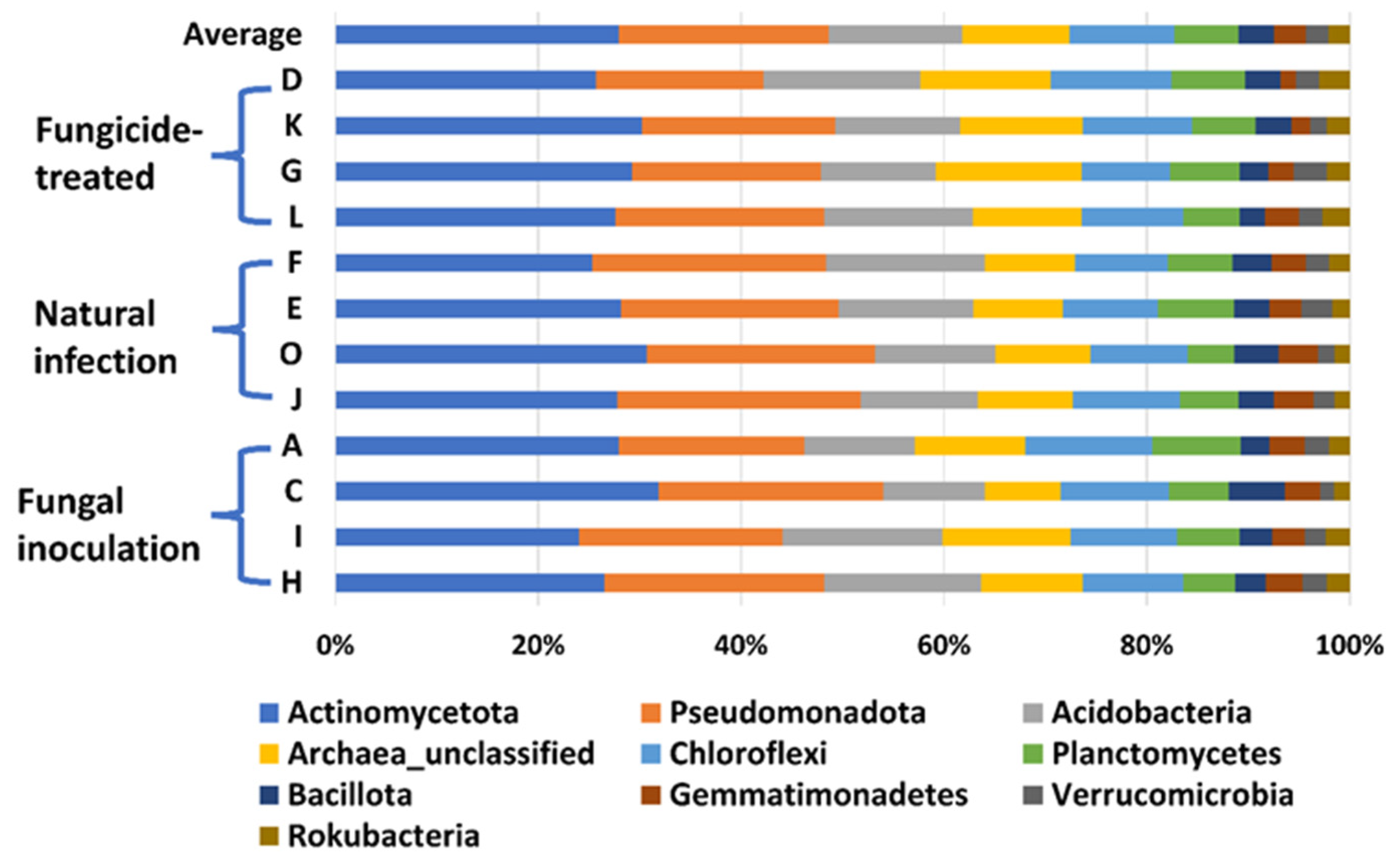
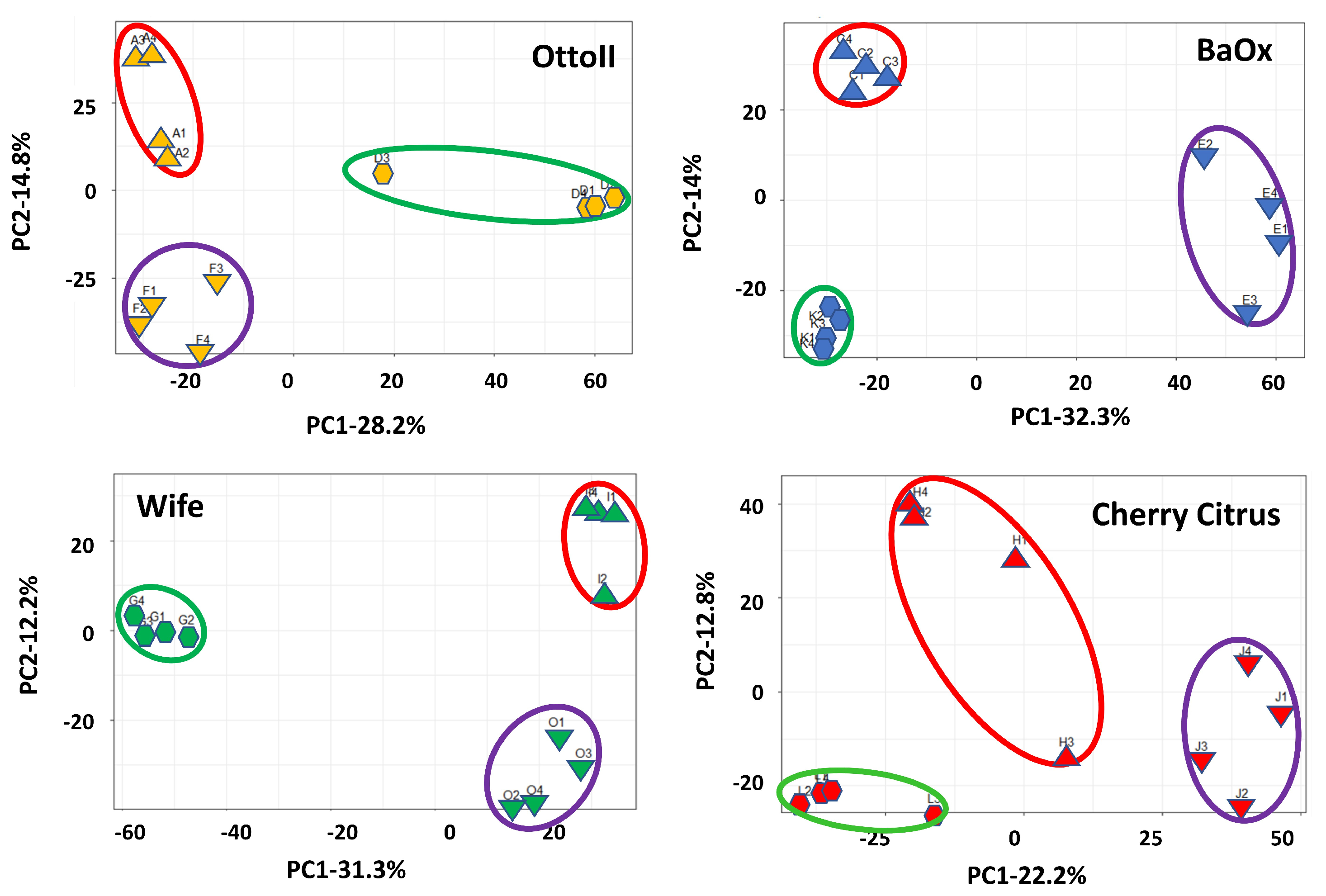
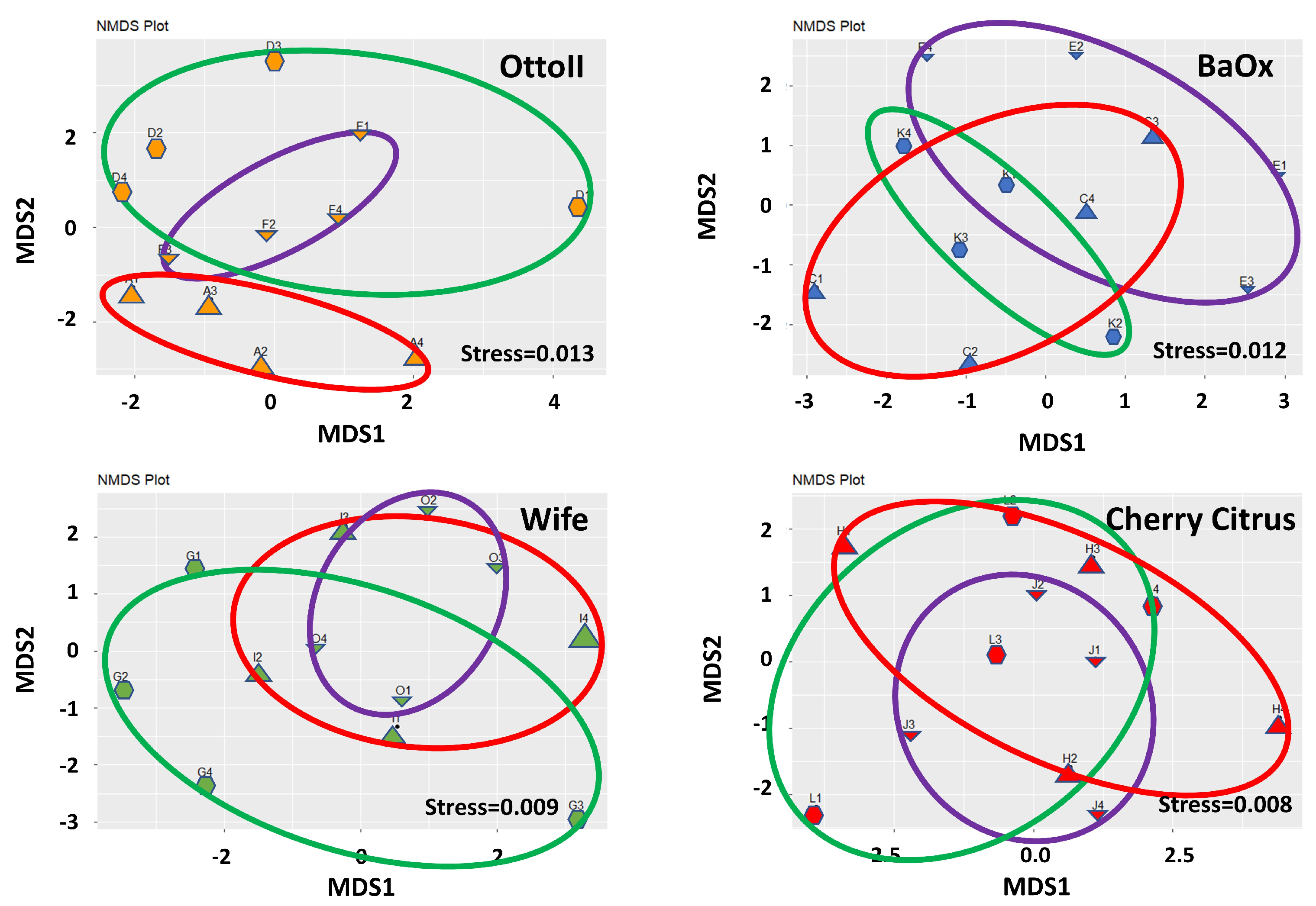
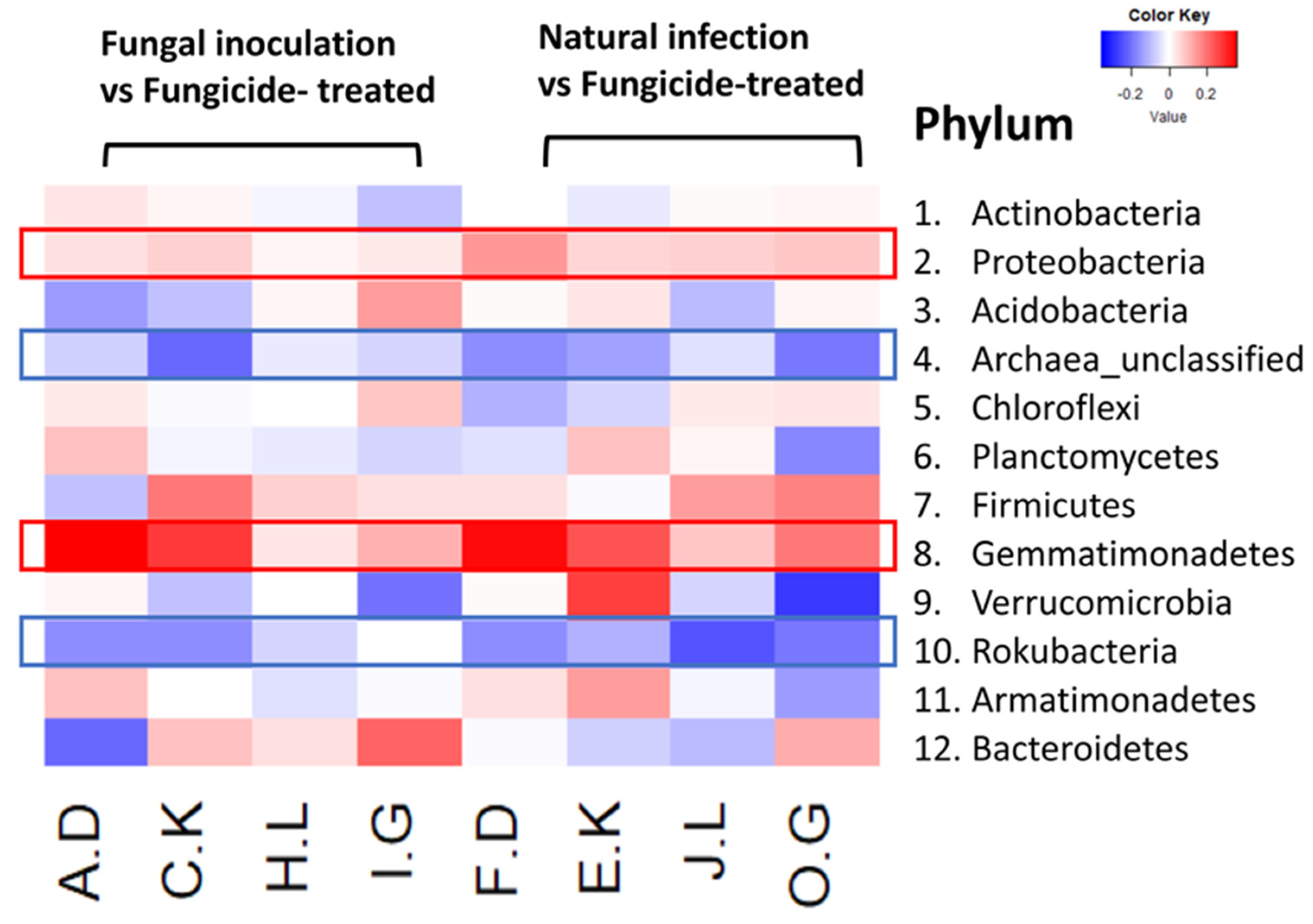

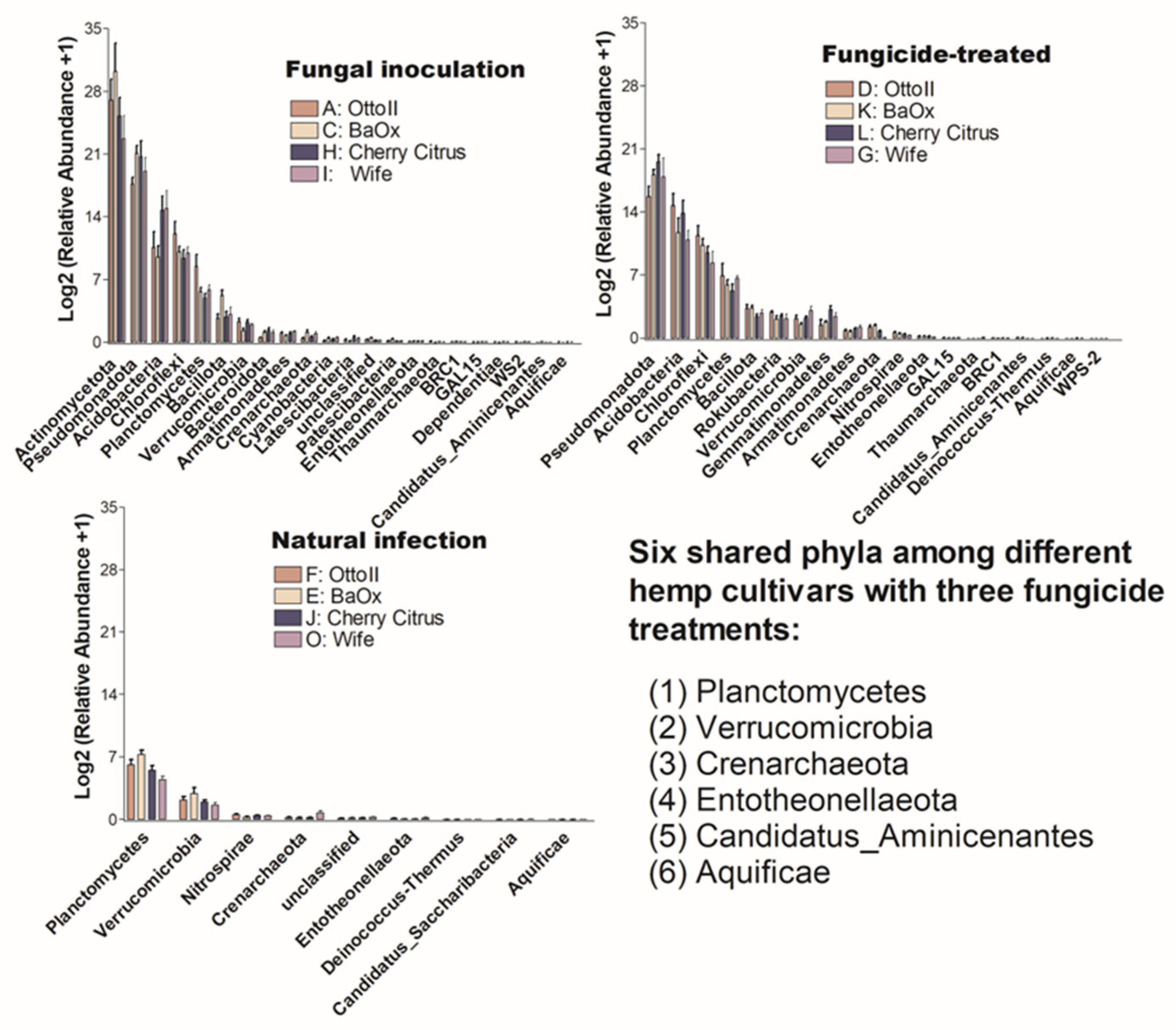

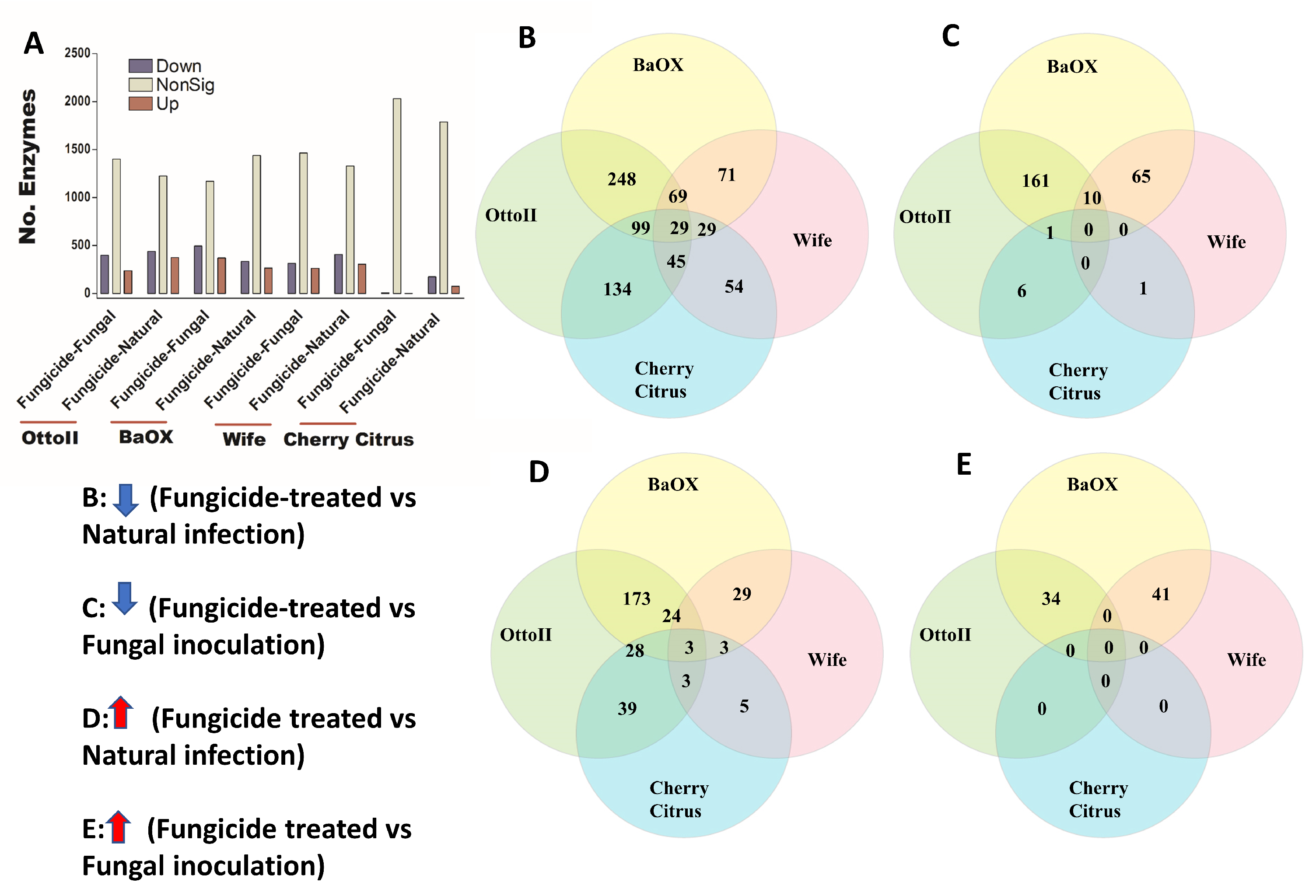

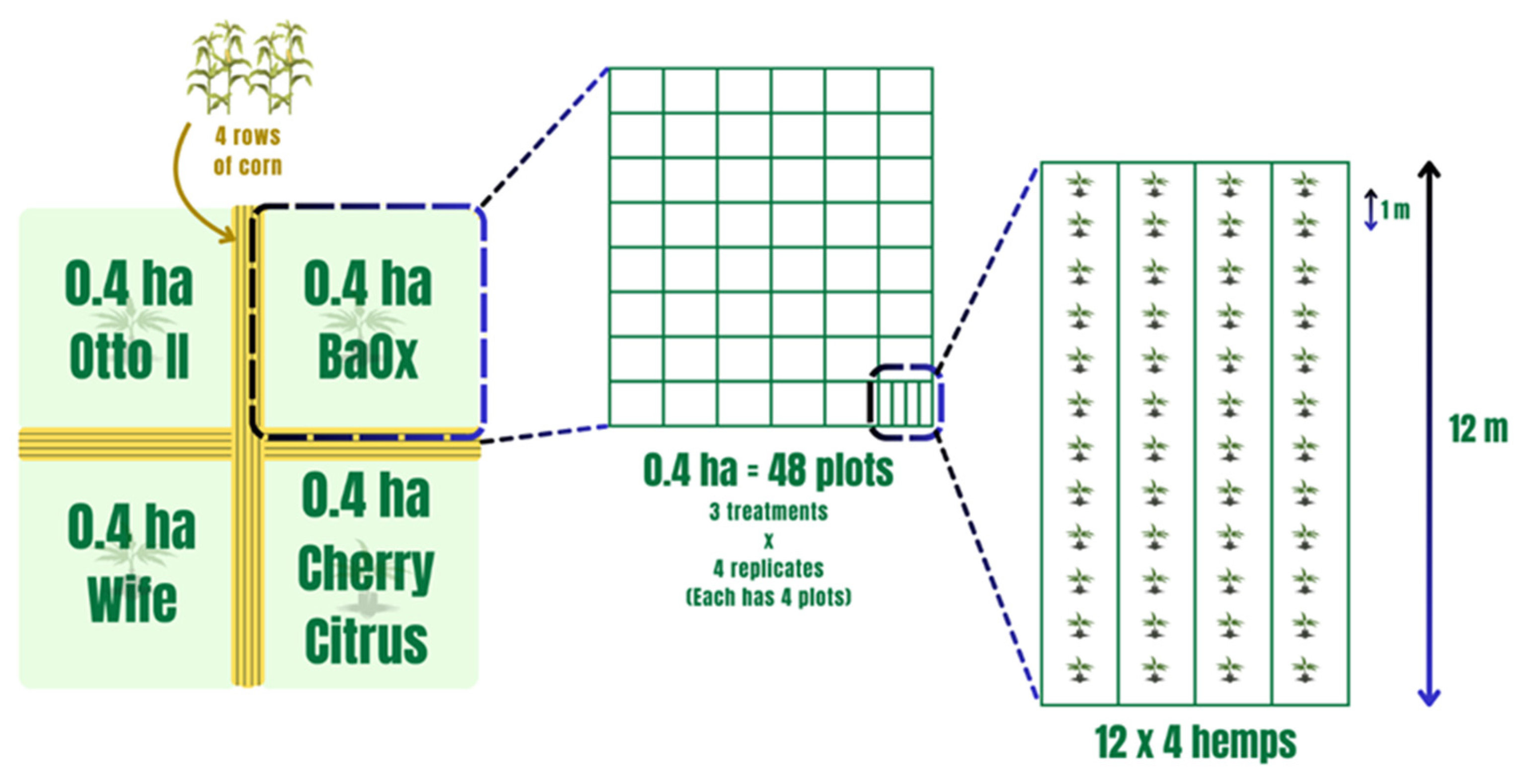
| Phylum | A | F | D | C | E | K | H | J | L | I | O | G | Average |
|---|---|---|---|---|---|---|---|---|---|---|---|---|---|
| Otto2 | Otto2 | Otto2 | BaOX | BaOX | BaOX | Cherry Citrus | Cherry Citrus | Cherry Citrus | Wife | Wife | Wife | ||
| Fungal inocul. | Natural infect. | Fungicide-treated | Fungal inocul. | Natural infect. | Fungicide-treated | Fungal inocul. | Natural infect. | Fungicide-treated | Fungal inocul. | Natural infect. | Fungicide-treated | ||
| Actinomycetota | 27.01 | 24.39 | 24.50 | 30.24 | 27.06 | 28.79 | 25.27 | 26.68 | 26.18 | 22.72 | 29.42 | 28.16 | 26.70 |
| Pseudomonadota | 17.63 | 22.15 | 15.71 | 21.10 | 20.64 | 18.14 | 20.70 | 23.09 | 19.55 | 19.06 | 21.52 | 17.90 | 19.77 |
| Acidobacteria | 10.57 | 15.09 | 14.74 | 9.50 | 12.76 | 11.73 | 14.72 | 11.08 | 13.89 | 14.93 | 11.41 | 10.92 | 12.61 |
| Archaea_unclassified | 10.48 | 8.52 | 12.27 | 7.12 | 8.50 | 11.47 | 9.54 | 8.98 | 10.19 | 11.95 | 8.98 | 13.84 | 10.15 |
| Chloroflexi | 12.12 | 8.83 | 11.38 | 10.11 | 8.99 | 10.29 | 9.39 | 10.19 | 9.48 | 9.95 | 9.17 | 8.35 | 9.85 |
| Planctomycetes | 8.44 | 6.14 | 6.92 | 5.65 | 7.27 | 5.94 | 4.93 | 5.50 | 5.26 | 5.82 | 4.45 | 6.65 | 6.08 |
| Bacillota | 2.69 | 3.71 | 3.31 | 5.19 | 3.30 | 3.36 | 2.84 | 3.32 | 2.39 | 3.08 | 4.16 | 2.76 | 3.34 |
| Gemmatimonadetes | 3.39 | 3.24 | 1.47 | 3.36 | 3.08 | 1.78 | 3.49 | 3.81 | 3.17 | 3.07 | 3.69 | 2.40 | 3.00 |
| Verrucomicrobia | 2.28 | 2.21 | 2.16 | 1.28 | 2.91 | 1.57 | 2.24 | 1.95 | 2.25 | 1.96 | 1.60 | 3.08 | 2.13 |
| Rokubacteria | 1.99 | 1.96 | 2.87 | 1.47 | 1.66 | 2.12 | 2.19 | 1.46 | 2.52 | 2.20 | 1.41 | 2.19 | 2.00 |
| Armatimonadetes | 1.04 | 0.96 | 0.85 | 0.77 | 1.04 | 0.76 | 0.98 | 1.05 | 1.09 | 1.18 | 0.88 | 1.21 | 0.99 |
| Bacteroidota | 0.52 | 0.82 | 0.83 | 1.11 | 0.77 | 0.90 | 1.35 | 0.97 | 1.21 | 1.07 | 0.84 | 0.64 | 0.92 |
| Crenarchaeota | 0.42 | 0.23 | 1.22 | 1.12 | 0.17 | 1.40 | 0.59 | 0.21 | 0.81 | 0.96 | 0.75 | 0.05 | 0.66 |
| Nitrospirae | 0.25 | 0.57 | 0.63 | 0.39 | 0.28 | 0.52 | 0.38 | 0.46 | 0.44 | 0.43 | 0.41 | 0.34 | 0.42 |
| Latescibacteria | 0.29 | 0.39 | 0.23 | 0.11 | 0.50 | 0.21 | 0.50 | 0.21 | 0.43 | 0.39 | 0.24 | 0.41 | 0.32 |
| Cyanobacteria | 0.16 | 0.27 | 0.17 | 0.40 | 0.36 | 0.35 | 0.27 | 0.33 | 0.39 | 0.51 | 0.29 | 0.22 | 0.31 |
| unclassified | 0.29 | 0.12 | 0.22 | 0.47 | 0.17 | 0.22 | 0.16 | 0.16 | 0.19 | 0.22 | 0.25 | 0.25 | 0.23 |
| Patescibacteria | 0.12 | 0.10 | 0.08 | 0.31 | 0.23 | 0.06 | 0.08 | 0.31 | 0.11 | 0.12 | 0.17 | 0.22 | 0.16 |
| Entotheonellaeota | 0.06 | 0.12 | 0.21 | 0.10 | 0.06 | 0.20 | 0.14 | 0.06 | 0.22 | 0.16 | 0.17 | 0.11 | 0.13 |
| Fibrobacteres | 0.03 | 0.05 | 0.02 | 0.03 | 0.06 | 0.03 | 0.04 | 0.03 | 0.04 | 0.04 | 0.03 | 0.04 | 0.04 |
| Thaumarchaeota | 0.11 | 0.01 | 0.00 | 0.00 | 0.06 | 0.00 | 0.03 | 0.03 | 0.00 | 0.01 | 0.01 | 0.10 | 0.03 |
| BRC1 | 0.02 | 0.02 | 0.03 | 0.07 | 0.03 | 0.02 | 0.03 | 0.02 | 0.03 | 0.03 | 0.02 | 0.02 | 0.03 |
| GAL15 | 0.01 | 0.02 | 0.05 | 0.01 | 0.02 | 0.01 | 0.03 | 0.01 | 0.02 | 0.02 | 0.02 | 0.06 | 0.02 |
| Dependentiae | 0.01 | 0.01 | 0.02 | 0.00 | 0.02 | 0.05 | 0.03 | 0.00 | 0.03 | 0.02 | 0.01 | 0.03 | 0.02 |
| Elusimicrobia | 0.01 | 0.02 | 0.02 | 0.01 | 0.02 | 0.02 | 0.02 | 0.02 | 0.03 | 0.02 | 0.01 | 0.03 | 0.02 |
| Deinococcus-Thermus | 0.02 | 0.01 | 0.00 | 0.03 | 0.01 | 0.01 | 0.01 | 0.02 | 0.02 | 0.02 | 0.03 | 0.00 | 0.01 |
| Candidatus_ Saccharibacteria | 0.00 | 0.01 | 0.01 | 0.03 | 0.00 | 0.01 | 0.01 | 0.01 | 0.02 | 0.02 | 0.04 | 0.00 | 0.01 |
| WS2 | 0.01 | 0.01 | 0.01 | 0.00 | 0.01 | 0.01 | 0.02 | 0.00 | 0.01 | 0.02 | 0.00 | 0.01 | 0.01 |
| WPS-2 | 0.00 | 0.00 | 0.00 | 0.00 | 0.00 | 0.00 | 0.00 | 0.00 | 0.00 | 0.00 | 0.00 | 0.00 | 0.00 |
| FCPU426 | 0.00 | 0.00 | 0.00 | 0.00 | 0.00 | 0.00 | 0.00 | 0.00 | 0.00 | 0.00 | 0.00 | 0.00 | 0.00 |
| Others | 0.03 | 0.02 | 0.07 | 0.04 | 0.03 | 0.05 | 0.03 | 0.03 | 0.03 | 0.02 | 0.02 | 0.02 | 0.03 |
| Otto2 | BaOx | Wife | Cherry Dwarf | Up/Down Regulation | ||
|---|---|---|---|---|---|---|
| Function | Description | logFC | logFC | logFC | logFC | |
| COG1690 | RNA-splicing ligase RtcB, repairs tRNA damage | 0.23 | 0.15 | 0.17 | 0.20 | Up |
| COG1085 | Galactose-1-phosphate uridylyltransferase | 0.23 | 0.15 | 0.16 | 0.15 | Up |
| COG1321 | Mn-dependent transcriptional regulator, DtxR family | 0.21 | 0.16 | 0.12 | 0.14 | Up |
| COG1331 | Uncharacterized conserved protein YyaL, SSP411 family, contains hioredoxin and six-hairpin glycosidase-like domains | 0.18 | 0.14 | 0.11 | 0.14 | Up |
| COG0543 | NAD(P)H-flavin reductase | 0.13 | 0.12 | 0.13 | 0.14 | Up |
| COG0083 | Homoserine kinase | 0.23 | 0.14 | 0.12 | 0.13 | Up |
| COG1531 | Uncharacterized protein, UPF0248 family | −2.57 | −1.55 | −1.04 | −2.36 | Down |
| COG3756 | Uncharacterized conserved protein YdaU, DUF1376 family | −1.62 | −1.37 | −1.30 | −1.98 | Down |
| COG5519 | Uncharacterized protein, DUF927 family | −1.64 | −0.65 | −0.80 | −1.55 | Down |
| COG1783 | Phage terminase large subunit | −0.70 | −0.62 | −1.88 | −1.50 | Down |
| COG3900 | Predicted periplasmic protein | −0.88 | −0.86 | −0.67 | −1.21 | Down |
| COG3524 | Capsule polysaccharide export protein KpsE/RkpR | −1.06 | −0.74 | −0.55 | −1.15 | Down |
| COG3338 | Carbonic anhydrase | −1.18 | −0.92 | −0.45 | −1.12 | Down |
| COG4378 | Uncharacterized protein | −1.30 | −0.99 | −1.14 | −0.97 | Down |
| COG4452 | Inner membrane protein involved in colicin E2 resistance | −1.11 | −0.73 | −0.62 | −0.87 | Down |
| COG4228 | Mu-like prophage DNA circulation protein | −1.24 | −1.24 | −1.02 | −0.78 | Down |
| COG3724 | Succinylarginine dihydrolase | −1.19 | −0.60 | −0.73 | −0.78 | Down |
| COG5339 | Uncharacterized conserved protein YdgA, DUF945 family | −1.42 | −1.16 | −0.89 | −0.77 | Down |
| COG4384 | Mu-like prophage protein gp45 | −1.50 | −1.28 | −1.17 | −0.76 | Down |
| COG5316 | Uncharacterized protein | −1.08 | −0.67 | −0.61 | −0.75 | Down |
| COG3784 | Uncharacterized conserved protein YdbL, DUF1318 family | −1.04 | −0.52 | −0.68 | −0.74 | Down |
| COG3778 | Uncharacterized protein YmfQ in lambdoid prophage, DUF2313 family | −1.10 | −1.15 | −1.04 | −0.74 | Down |
| COG4381 | Mu-like prophage protein gp46 | −1.10 | −1.15 | −1.04 | −0.74 | Down |
| COG5005 | Mu-like prophage protein gpG | −1.40 | −1.22 | −1.04 | −0.73 | Down |
| COG4379 | Mu-like prophage tail protein gpP | −0.99 | −1.07 | −1.07 | −0.71 | Down |
| COG4386 | Mu-like prophage tail sheath protein gpL | −0.99 | −1.07 | −1.07 | −0.71 | Down |
| COG5003 | Mu-like prophage protein gp37 | −1.88 | −1.23 | −1.10 | −0.71 | Down |
| COG5455 | Periplasmic regulator RcnB of Ni and Co efflux | −0.78 | −0.45 | −0.59 | −0.70 | Down |
| COG3299 | Uncharacterized phage protein gp47/JayE | −0.68 | −0.65 | −0.75 | −0.70 | Down |
| COG2866 | Murein tripeptide amidase MpaA | −0.97 | −0.67 | −0.46 | −0.67 | Down |
| COG3798 | Uncharacterized protein | −0.80 | −0.57 | −0.42 | −0.64 | Down |
| COG3819 | Uncharacterized membrane protein | −1.24 | −0.92 | −0.52 | −0.64 | Down |
| COG3817 | Uncharacterized membrane protein | −1.25 | −0.92 | −0.51 | −0.63 | Down |
| COG3868 | Uncharacterized protein | −0.90 | −0.43 | −0.44 | −0.63 | Down |
| COG3577 | Predicted aspartyl protease | −0.55 | −0.38 | −0.44 | −0.61 | Down |
| COG5622 | Protein required for attachment to host cells | −0.57 | −0.33 | −0.38 | −0.60 | Down |
| COG3853 | Uncharacterized conserved protein YaaN involved in tellurite resistance | −0.36 | −0.31 | −0.51 | −0.60 | Down |
| COG5478 | Low-affinity Fe/Cu permease | −0.55 | −0.34 | −0.43 | −0.59 | Down |
| COG0027 | Formate-dependent phosphoribosylglycinamide formyltransferase (GAR transformylase) | −0.63 | −0.39 | −0.39 | −0.57 | Down |
| COG4525 | ABC-type taurine transport system, ATPase component | −0.47 | −0.53 | −0.37 | −0.55 | Down |
| COG3174 | Uncharacterized membrane protein, DUF4010 family | −0.93 | −0.65 | −0.60 | −0.55 | Down |
| COG1755 | Uncharacterized protein YpbQ, isoprenylcysteine carboxyl methyltransferase (ICMT) family | −0.37 | −0.41 | −0.44 | −0.55 | Down |
| COG3138 | Arginine/ornithine N-succinyltransferase beta subunit | −0.94 | −0.50 | −0.47 | −0.53 | Down |
| COG0418 | Dihydroorotase | −0.82 | −0.46 | −0.43 | −0.52 | Down |
| COG4960 | Flp pilus assembly protein, protease CpaA | −0.66 | −0.36 | −0.32 | −0.50 | Down |
| COG5454 | Predicted secreted protein | −0.58 | −0.32 | −0.41 | −0.49 | Down |
| COG2941 | Demethoxyubiquinone hydroxylase, CLK1/Coq7/Cat5 family | −0.90 | −0.48 | −0.38 | −0.49 | Down |
| COG3762 | Uncharacterized membrane protein | −0.58 | −0.26 | −0.44 | −0.49 | Down |
| COG3159 | Uncharacterized conserved protein YigA, DUF484 family | −0.81 | −0.39 | −0.40 | −0.47 | Down |
| COG5317 | Uncharacterized protein | −0.46 | −0.30 | −0.26 | −0.46 | Down |
| COG3908 | Uncharacterized protein | −0.45 | −0.29 | −0.29 | −0.45 | Down |
| COG3909 | Cytochrome c556 | −0.53 | −0.32 | −0.41 | −0.44 | Down |
| COG5509 | Uncharacterized small protein, DUF1192 family | −0.42 | −0.25 | −0.32 | −0.44 | Down |
| COG3094 | Uncharacterized membrane protein SirB2 | −0.75 | −0.42 | −0.50 | −0.44 | Down |
| COG4783 | Putative Zn-dependent protease contains TPR repeats | −0.69 | −0.39 | −0.30 | −0.44 | Down |
| COG4784 | Putative Zn-dependent protease | −0.71 | −0.51 | −0.38 | −0.43 | Down |
| COG5507 | Uncharacterized conserved protein YbaA, DUF1428 family | −0.46 | −0.25 | −0.27 | −0.43 | Down |
| COG1448 | Aspartate/tyrosine/aromatic aminotransferase | −0.68 | −0.49 | −0.43 | −0.42 | Down |
| COG4765 | Uncharacterized protein | −0.49 | −0.29 | −0.29 | −0.42 | Down |
| COG3807 | SH3-like domain | −0.52 | −0.30 | −0.27 | −0.42 | Down |
| COG2824 | Uncharacterized Zn-ribbon-containing protein | −0.55 | −0.46 | −0.47 | −0.42 | Down |
| COG5447 | Uncharacterized protein | −0.48 | −0.27 | −0.29 | −0.42 | Down |
| COG5458 | Uncharacterized protein | −0.48 | −0.27 | −0.30 | −0.42 | Down |
| COG4544 | Uncharacterized conserved protein | −0.43 | −0.27 | −0.30 | −0.41 | Down |
| COG5481 | Uncharacterized protein | −0.47 | −0.26 | −0.25 | −0.41 | Down |
| COG5385 | Uncharacterized protein | −0.48 | −0.26 | −0.32 | −0.41 | Down |
| COG5360 | Uncharacterized conserved protein, heparinase superfamily | −0.45 | −0.25 | −0.28 | −0.41 | Down |
| COG3128 | Predicted 2-oxoglutarate- and Fe(II)-dependent dioxygenase YbiX | −0.86 | −0.57 | −0.29 | −0.40 | Down |
| COG1956 | GAF domain-containing protein, putative methionine-R-sulfoxide reductase | −0.48 | −0.35 | −0.55 | −0.40 | Down |
| COG5452 | Uncharacterized protein | −0.47 | −0.25 | −0.31 | −0.40 | Down |
| COG5416 | Uncharacterized integral membrane protein | −0.34 | −0.25 | −0.20 | −0.40 | Down |
| COG2733 | Uncharacterized membrane-anchored protein YjiN, DUF445 family | −0.50 | −0.36 | −0.31 | −0.39 | Down |
| COG2032 | Cu/Zn superoxide dismutase | −0.29 | −0.23 | −0.29 | −0.39 | Down |
| COG4120 | ABC-type uncharacterized transport system, permease component | −0.22 | −0.26 | −0.41 | −0.39 | Down |
| COG2747 | Negative regulator of flagellin synthesis (anti-sigma28 factor) | −0.47 | −0.30 | −0.29 | −0.38 | Down |
| COG5265 | ABC-type transport system involved in Fe-S cluster assembly, permease, and ATPase components | −0.56 | −0.29 | −0.25 | −0.37 | Down |
| COG5394 | Polyhydroxyalkanoate (PHA) synthesis regulator protein, binds DNA and PHA | −0.56 | −0.29 | −0.24 | −0.37 | Down |
| COG3175 | Cytochrome c oxidase assembly protein Cox11 | −0.56 | −0.30 | −0.26 | −0.37 | Down |
| COG2932 | Phage repressor protein C contains Cro/C1-type HTH and peptidase s24 domains | −0.47 | −0.30 | −0.25 | −0.37 | Down |
| COG2821 | Membrane-bound lytic murein transglycosylase | −0.58 | −0.28 | −0.26 | −0.35 | Down |
| COG2935 | Arginyl-tRNA—protein-N-Asp/Glu arginylyltransferase | −0.49 | −0.25 | −0.25 | −0.34 | Down |
| COG2827 | Predicted endonuclease, GIY-YIG superfamily | −0.46 | −0.33 | −0.18 | −0.34 | Down |
| COG3158 | K+ transporter | −0.56 | −0.34 | −0.23 | −0.32 | Down |
| COG1986 | Non-canonical (house-cleaning) NTP pyrophosphatase, all-alpha NTP-Ppase family | −0.50 | −0.60 | −0.56 | −0.32 | Down |
| COG2385 | Peptidoglycan hydrolase (amidase) enhancer domain | −0.48 | −0.55 | −0.51 | −0.31 | Down |
| COG3169 | Uncharacterized conserved protein, DUF486 family | −0.58 | −0.43 | −0.31 | −0.31 | Down |
| COG4145 | Na+/panthothenate symporter | −0.53 | −0.75 | −0.58 | −0.31 | Down |
| COG0397 | Uncharacterized conserved protein YdiU, UPF0061 family | −0.47 | −0.28 | −0.25 | −0.30 | Down |
| COG2840 | DNA-nicking endonuclease, Smr domain | −0.51 | −0.23 | −0.24 | −0.30 | Down |
| COG3920 | Two-component sensor histidine kinase, HisKA, and HATPase domains | −0.29 | −0.19 | −0.15 | −0.27 | Down |
| COG0610 | Type I site-specific restriction-modification system, R (restriction) subunit, and related helicases | −0.59 | −0.46 | −0.22 | −0.26 | Down |
| COG1281 | Redox-regulated molecular chaperone, HSP33 family | −0.38 | −0.17 | −0.26 | −0.23 | Down |
| COG1565 | SAM-dependent methyltransferase, MidA family | −0.30 | −0.19 | −0.15 | −0.23 | Down |
| COG0807 | GTP cyclohydrolase II | −0.48 | −0.32 | −0.22 | −0.22 | Down |
| COG073′ | 2′,3’-cyclic-nucleotide 2’-phosphodiesteras’/5’- o’ 3’-nucleotidase 5’-nucleotidase family | −0.29 | −0.19 | −0.22 | −0.19 | Down |
| COG1764 | Organic hydroperoxide reductase OsmC/OhrA | −0.19 | −0.16 | −0.11 | −0.13 | Down |
| COG1393 | Arsenate reductase and related proteins, glutaredoxin family | −0.23 | −0.13 | −0.15 | −0.11 | Down |
| COG1301 | Na+/H+-dicarboxylate symporter | −0.23 | −0.19 | −0.15 | −0.10 | Down |
| Otto II | BaOx | Wife | Cherry Dwarf | Up/Down | ||
|---|---|---|---|---|---|---|
| Function | Description | logFC | logFC | logFC | logFC | |
| EC:6.5.1.3 | RNA ligase (ATP) | 0.22 | 0.14 | 0.14 | 0.18 | Up |
| EC:2.5.1.29 | Geranylgeranyl diphosphate synthase | 0.17 | 0.10 | 0.12 | 0.12 | Up |
| EC:5.4.2.12 | Phosphoglycerate mutase (2,3-diphosphoglycerate-independent) | 0.12 | 0.08 | 0.05 | 0.07 | Up |
| EC:1.1.1.276 | Serine 3-dehydrogenase (NADP(+)) | −1.54 | −0.78 | −0.94 | −1.02 | Down |
| EC:1.2.1.71 | Succinylglutamate-semialdehyde dehydrogenase | −1.28 | −0.74 | −0.72 | −0.82 | Down |
| EC:1.2.1.24 | Succinate-semialdehyde dehydrogenase (NAD(+)) | −1.88 | −1.24 | −1.10 | −0.80 | Down |
| EC:3.5.3.23 | N-succinylarginine dihydrolase | −1.20 | −0.61 | −0.74 | −0.78 | Down |
| EC:1.4.99.6 | D-arginine dehydrogenase | −1.10 | −0.62 | −0.65 | −0.75 | Down |
| EC:3.2.1.99 | Arabinan endo-1,5-alpha-L-arabinosidase | −0.75 | −0.54 | −0.57 | −0.74 | Down |
| EC:1.3.3.5 | Bilirubin oxidase | −1.33 | −0.92 | −1.01 | −0.74 | Down |
| EC:1.1.1.48 | D-galactose 1-dehydrogenase | −0.59 | −0.41 | −0.56 | −0.64 | Down |
| EC:1.14.11.2 | Procollagen-proline dioxygenase | −0.58 | −0.40 | −0.63 | −0.59 | Down |
| EC:5.2.1.2 | Maleylacetoacetate isomerase | −0.72 | −0.42 | −0.52 | −0.55 | Down |
| EC:2.3.1.109 | Arginine N-succinyltransferase | −0.95 | −0.51 | −0.48 | −0.54 | Down |
| EC:5.1.1.13 | Aspartate racemase | −0.63 | −0.32 | −0.63 | −0.53 | Down |
| EC:2.6.1.57 | Aromatic-amino-acid transaminase | −0.98 | −0.69 | −0.45 | −0.50 | Down |
| EC:3.1.2.12 | S-formylglutathione hydrolase | −0.71 | −0.42 | −0.26 | −0.47 | Down |
| EC:1.2.1.91 | 3-oxo-5,6-dehydrosuberyl-CoA semialdehyde dehydrogenase | −0.72 | −0.54 | −0.32 | −0.39 | Down |
| EC:3.3.2.12 | Oxepin-CoA hydrolase | −0.72 | −0.54 | −0.32 | −0.39 | Down |
| EC:2.3.2.8 | Arginyltransferase | −0.50 | −0.26 | −0.26 | −0.35 | Down |
| EC:6.4.1.4 | Methylcrotonoyl-CoA carboxylase | −0.40 | −0.23 | −0.25 | −0.33 | Down |
| EC:3.5.2.9 | 5-oxoprolinase (ATP-hydrolyzing) | −0.42 | −0.22 | −0.29 | −0.33 | Down |
| EC:2.3.1.223 | 3-oxo-5,6-didehydrosuberyl-CoA thiolase | −0.73 | −0.96 | −0.62 | −0.33 | Down |
| EC:3.4.11.19 | D-stereospecific aminopeptidase | −0.41 | −0.36 | −0.33 | −0.30 | Down |
| EC:5.4.99.28 | tRNA pseudouridine(32) synthase | −0.51 | −0.36 | −0.25 | −0.29 | Down |
| EC:5.4.99.29 | 23S rRNA pseudouridine(746) synthase | −0.51 | −0.36 | −0.25 | −0.29 | Down |
| EC:1.3.3.3 | Coproporphyrinogen oxidase | −0.55 | −0.29 | −0.31 | −0.26 | Down |
| EC:3.4.11.5 | Prolyl aminopeptidase | −0.40 | −0.26 | −0.20 | −0.21 | Down |
| EC:2.3.1.117 | 2,3,4,5-tetrahydropyridine-2,6-dicarboxylate N-succinyltransferase | −0.33 | −0.17 | −0.15 | −0.18 | Down |
| EC:3.5.1.28 | N-acetylmuramoyl-L-alanine amidase | −0.13 | −0.12 | −0.17 | −0.12 | Down |
| EC:2.7.1.69 | Protein-N(pi)-phosphohistidine--sugar phosphotransferase | −0.21 | −0.22 | −0.09 | −0.11 | Down |
| EC:3.1.11.2 | Exodeoxyribonuclease III | −0.20 | −0.14 | −0.09 | −0.10 | Down |
| Otto II | BaOx | Wife | Cherry Dwarf | Up/Down | ||
|---|---|---|---|---|---|---|
| Pathways | Description | logFC | logFC | logFC | logFC | |
| TYRFUMCAT-PWY | L-tyrosine degradation I | −0.77 | −0.52 | −0.34 | −0.37 | Down |
Disclaimer/Publisher’s Note: The statements, opinions and data contained in all publications are solely those of the individual author(s) and contributor(s) and not of MDPI and/or the editor(s). MDPI and/or the editor(s) disclaim responsibility for any injury to people or property resulting from any ideas, methods, instructions or products referred to in the content. |
© 2024 by the authors. Licensee MDPI, Basel, Switzerland. This article is an open access article distributed under the terms and conditions of the Creative Commons Attribution (CC BY) license (https://creativecommons.org/licenses/by/4.0/).
Share and Cite
Xu, J.; Knight, T.; Boone, D.; Saleem, M.; Finley, S.J.; Gauthier, N.; Ayariga, J.A.; Akinrinlola, R.; Pulkoski, M.; Britt, K.; et al. Influence of Fungicide Application on Rhizosphere Microbiota Structure and Microbial Secreted Enzymes in Diverse Cannabinoid-Rich Hemp Cultivars. Int. J. Mol. Sci. 2024, 25, 5892. https://doi.org/10.3390/ijms25115892
Xu J, Knight T, Boone D, Saleem M, Finley SJ, Gauthier N, Ayariga JA, Akinrinlola R, Pulkoski M, Britt K, et al. Influence of Fungicide Application on Rhizosphere Microbiota Structure and Microbial Secreted Enzymes in Diverse Cannabinoid-Rich Hemp Cultivars. International Journal of Molecular Sciences. 2024; 25(11):5892. https://doi.org/10.3390/ijms25115892
Chicago/Turabian StyleXu, Junhuan, Tyson Knight, Donchel Boone, Muhammad Saleem, Sheree J. Finley, Nicole Gauthier, Joseph A. Ayariga, Rufus Akinrinlola, Melissa Pulkoski, Kadie Britt, and et al. 2024. "Influence of Fungicide Application on Rhizosphere Microbiota Structure and Microbial Secreted Enzymes in Diverse Cannabinoid-Rich Hemp Cultivars" International Journal of Molecular Sciences 25, no. 11: 5892. https://doi.org/10.3390/ijms25115892





